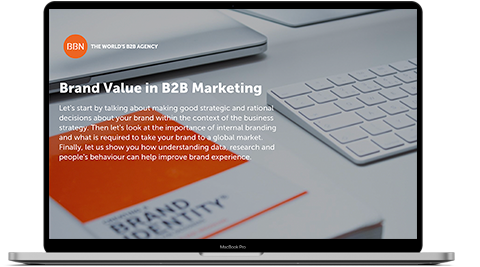Posted by BBN Central on 23rd Apr 2024
Quality Over Quantity: A Strategic Content Investment
Welcome to the fourth instalment in our series of seven articles, each dedicated to exploring smart investment strategies for fearless
READ MOREPosted by BBN Central on 21st Jul 2023
Global content marketers often face the balancing act of producing relevant, helpful content and reaching the appropriate global audience. While our experts haven’t uncovered a novel new media channel or way to communicate globally, they offer interesting insights about what it takes to be locally relevant with customers.
B2B marketers know it’s important to put global audiences at ease when consuming marketing messages. Of course, that means translating content whenever feasible. But companies take different approaches to this, mostly influenced by perceived complexity and overall cost.
Thomas Heide Jorgenson, head of marketing communication at Danfoss, noted that most of their master materials are created using English and then translated into local languages. Two countries, China and Russia, are given much more flexibility in how content is adapted, with allowances for messaging changes where cultural and audience differences may dictate a shift.
Esther Oon-Bybjerg, group director of corporate communications for GAC Group, stated that despite a strong, centralized approach to messaging and campaign ideas, GAC provides a lot of local freedom. “It’s either global or it’s local. And when it’s local, we need to make sure what we’re doing is ideal for the audience. There are no ‘regional’ compromises for this. Proximity does not mean similarity.”
Localization goes beyond translations. Shea Vincent, senior marketing director for BioLife Solutions, said a key local consideration is customer relevance. “We encourage creating case studies, customer references and testimonials that are geographically relevant and trusted locally. The more local and relevant, the more belief you can instil that your brand and offerings are taken seriously in the target geo.”
The B2B marketing field has converged on another area of agreement: social media.
When it comes to content dissemination across social channels, our B2B clients are unanimous in their preference (if almost exclusive use) of LinkedIn.
Marketing leaders from Cummins, AAK, Flowserve, Danfoss and others cited LinkedIn as their main focus for social media strategy. But because of cultural differences and governmental policies, LinkedIn is a notable exception for Chinese markets. In late 2021, LinkedIn removed the platform from China entirely. So, what’s a marketer to do about establishing a social media presence there? The default answer right now is WeChat. However, Western companies could have trouble penetrating this channel in meaningful ways without help.
Vincent takes the path of least resistance for BioLife Solutions’ content in China. She leverages a Chinese distributor who shares their social media content as part of their distribution agreement. The same goes for Vijith Basheer, global marketing leader for valves, actuators and positioners for Flowserve. “Venturing into WeChat as an American company comes with challenges. One potential approach we are exploring is to seek partners in China who can aggregate content on WeChat for end users and engineering companies in target segments.”
While the choice of channels seems straightforward — LinkedIn and WeChat — the decision to localize is more challenging. Jorgenson said that while Danfoss does run local social media campaigns, it’s not a global practice. “It is a challenge to set up and run effective local campaigns where there simply isn’t follower volume to justify this. Therefore, we still spend most of our effort on creating global campaigns.”
Flowserve examines messaging apps in markets where long commutes on public transportation are the norm. “We’re not there yet, but we want to figure out how to deliver mobile content via messaging apps where we know our audiences are spending long periods of time on their phones,” said Deepak Sivanandan, head of global marketing for Flowserve. “This will become more of a priority as we move forward.”
While our experts talked mostly about digital channels, a few revealing comments were made about print.
See Also: The Marketing Globetrotter: The Challenges of Global Messaging
Monica Arroyave, senior director of consumer solutions at Gilbarco Veeder-Root, noted that customers in Mexico have traditional preferences. “Our customers in Mexico still embrace the tactile deliverable. They want something physical they can hold and experience. It’s important to recognize these country-specific differences and not fall into the trap that digital is the answer everywhere.”
One of the world’s fastest-growing and most important markets is also a print-centric market, according to Basheer. “Print is not dead in India. There is still a huge appetite for it, and that includes print advertising. Finding the right trade publications and working with media reps in India is imperative for building your presence there.”
And those media rep relationships can bear fruit in other ways beyond effective advertising campaigns.
While many of our panel members engage with the trade media more centrally,
Jessica Svahn, global brand manager at AAK, said their targeted PR and earned media efforts originate at the local level, with regional teams’ efforts supplemented by global initiatives in key trade media.
Jorgenson said Danfoss operates similarly. “Local media is run by our local market teams, often supported by corporate insights and resources. We help them assess the optimal target audience touch points from customer studies and apply those insights to build programs with trade publications with very targeted audiences.”
Whatever the manner you choose to leverage trade media — global or local — building strong relationships with editors should be at the centre of your strategy. “Global trade media is so important, but more important than advertising in these publications is connecting with the editors and reporters and establishing mutually beneficial relationships. If you can prove to be a valuable contributor to their editorial content, this can go a long way toward a steady presence for your brand in target geos,” explained Vincent.
When asked where they would focus efforts beyond digital media, our panellists nodded toward a fairly traditional mix of channels. The most noteworthy were:
And there’s that acronym: ABM. While our interviews didn’t reveal any detailed program results from ABM, it’s still a strong area of interest. We sense there’s frustration within the B2B marketing community related to realizing the full promise of ABM, but it’s still a viable practice that needs attention. If you’re getting ready to dip your toes into the ABM pool, we recommend you keep it simple, or you may find yourself awash in theories and martech additions that may not pay dividends.
About the Authorhis article was originally co-produced by U.S.-based BBN partner TriComB2B and Cross-Border Communications in a white paper published by TriComB2B titled ‘Top Considerations for Highly Effective B2B Global Marketing.’ TriComB2B is unabashedly devoted to industrial and technical B2B marketing, helping clients design optimised marketing strategies that drive decisions in complex, considered purchases. |
Posted by BBN Central on 21st Jul 2023
We've gathered thoughts and expertise from our top strategists to bring you this insightful publication in B2B marketing. Get our e-Book to understand how you can build brand value in your organisation.

1 email a month, EXCLUSIVE stories, and 10 minutes of your time.
Subscribe now
Posted by BBN Central on 23rd Apr 2024
Welcome to the fourth instalment in our series of seven articles, each dedicated to exploring smart investment strategies for fearless
READ MORE
Posted by BBN Central on 12th Apr 2024
Welcome to the third instalment, focusing on smart investment strategies for fearless marketers aiming to win market share in the
READ MORE
Posted by BBN Central on 5th Apr 2024
In B2B marketing, the compass that points businesses towards success is increasingly data-driven. Here at BBN, we've been keenly observing
READ MORE
Posted by BBN Central on 29th Mar 2024
Since the introduction of Sora, OpenAI's text-to-video model, the worlds of AI and marketing have been abuzz. It's being called
READ MORE